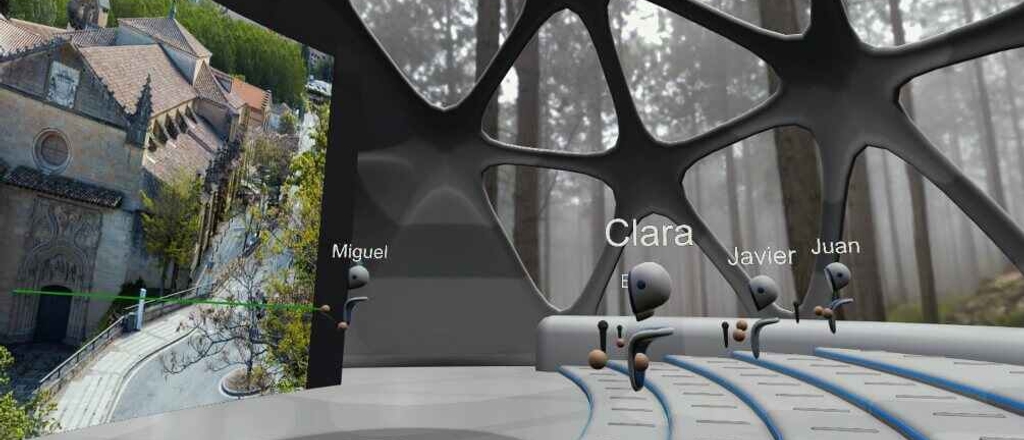- Home
- News And Events
- News
- Telefónica, Ie University And Nokia Have Launched The First Use Case In Spain That Applies 5g Technology, Virtual Reality And Edge Computing For The Delivery Of A Specialized Seminar Within The Framework Of University Studies
Telefónica, IE University and Nokia have launched the first use case in Spain that applies 5G technology, virtual reality and edge computing for the delivery of a specialized seminar within the framework of university studies

Based at IE University’s campus in Segovia, this educational application based on VR (virtual reality) and 5G technology has been developed to teach a specialized seminar on the architecture of the UNESCO World Heritage Site by Miguel Larrañaga, professor at the Humanities Center and Vice Rector of Students at IE University. In addition to the theoretical classes taught in a shared virtual space, the professor and students can walk through different 3D scenarios of the IE University seat in Segovia in real time. The building is located in the former Convent of Santa Cruz la Real, one of the most important buildings in the city from the 13th century, whose main entrance, cloister and chapter house boast a unique architectural wealth.
Thanks to edge computing and 5G technology, which provides a higher bandwidth and very low latency connection, it is possible to generate a realistic image of the virtual scenarios on the network along with 3D video streams in real time, specific to each user, ensuring a comfortable and realistic experience. The use of edge computing allows for minimal processing requirements onstudents' VR devices, so that more immersive experiences and more realistic graphics can be accessed even when using low-end VR glasses.
To implement this use case in education, Telefónica has deployed at IE University in Segovia, 5G NSA (Non Stand Alone) coverage through Nokia's AirScale Indoor Radio (ASiR) solution, that takes advantage of the edge computing deployed in Segovia to achieve the low latency required for the use case. Nokia has also made the necessary developments for the generation and transmition, with low latency, of the 3D video streams that are reproduced in the VR glasses worn by the students.
Students use a 5G smartphone and cardboard-type virtual reality glasses in which the cell phone is inserted.
Each student has cardboard-type virtual reality glasses in which a 5G cell phone is inserted, with which they access a virtual space consisting of a 3D classroom and a 360º recreation of the educational content. They have a remote control to interact with the application that enables them to move around the spaces or raise their hand in the virtual classroom, among other options.
Students and teacher are represented by avatar and can move around and go through the scenarios and content together, as well as hold conversations with each other.
Realistic 3D scenarios of the courtyard and main entrance, cloister and chapter house of the IE University seat in Segovia have been created using various techniques such as photogrammetry, which allows students, with the guidance of the expert, to move around these places virtually. This makes it easier to study and carry out part or all of the training in them, so that a much more immersive, personalized and detailed educational experience is created to almost “touch” the subject being taught.
Teachers use a more powerful VR equipment and a somewhat more complex interface that allows them use a virtual whiteboard, play 360º videos or activate 3D models that appear next to each student or guide them inside the 3D spaces with the possibility of pointing out architectural highlights.
“Segovia was the first technological city in Castilla y León to join Telefónica's 5G Technology Cities initiative to promote this technology in Spain.”
Mercedes Fernández, Innovation Manager at Telefónica Spain
She adds: “This use case applied to education is one more step in that initiative and adds to the other four developed in Segovia in the field of connected car, ehealth, tourism and transport to show the practical application of 5G with useful services to society and to various sectors of activity.”
José Luis Martín, Head of Tech Lab, Learning Innovation at IE University says: “This demonstrator is a clear example of how the inclusion of 5G and Telefónica's Edge Computing make it possible to overcome the limitations of mobile devices in the field of virtual reality. The technological and innovative nature of the project reflects IE's values and encourages us to continue at the forefront with this type of program where we see what technology can bring to education.”
Ignacio Gallego, President of Nokia Spain and Account Director of Telefónica Spain, concludes: “This project confirms the possibilities and benefits that 5G technology can offer when deployed on campuses, universities or other educational environments, in this case facilitating the integration and interaction of the physical with the virtual and the local with the remote.”